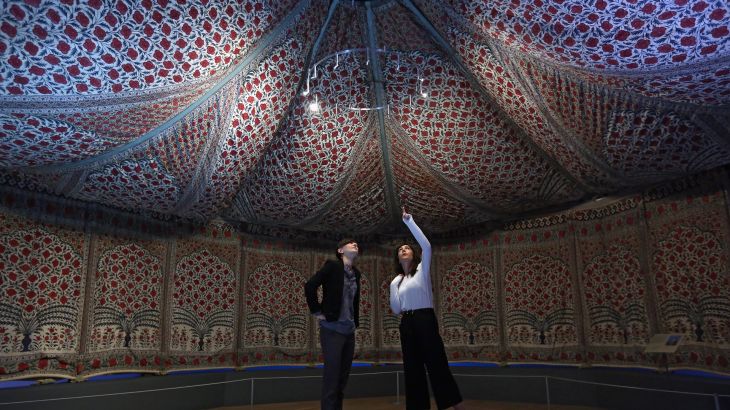The story of India, thread by thread
Exhibition in London highlights the historic influences, colourful dyes and exquisite craftsmanship of Indian fabrics.

London – It’s a colour explosion in every natural fabric imaginable: glorious feather-weight diaphanous cottons, reflective silver infused silks, patterned pashminas and soft wools.
The Fabric of India show spans thousands of years from a scrap of a third century blanket to contemporary Delhi designers.
Keep reading
list of 4 itemsUK returns looted Ghana artefacts on loan after 150 years
Fire engulfs iconic stock exchange building in Denmark’s Copenhagen
Inside the pressures facing Quebec’s billion-dollar maple syrup industry
Most of the 200 items are from the Victoria and Albert’s own collection.
A small side room is completely lined with a wall hanging, or bhitiya, made in the 1920s by Gujarat’s Kathi community.
The bold silk and cotton fabric would have decorated a room during a festival or marriage.
The wall hanging came via a circuitous route to the V and A: It was found abandoned in 1994 on a New York sidewalk.
There are plenty of other sumptuous items dyed with vibrant colours from turmeric plants, pomegranate rinds and crushed beetles.
But the most interesting part of the exhibition is Fabric and Freedom, which explains how fabric became in the 1930s a symbol of protest and national identity.
Resistance movement
European textiles, made cheap by the mass production of the industrial revolution, flooded the Indian market. Thousands of weavers, spinners and dyers lost their jobs.
“The response to that was a resistance movement called swadeshi, which means own country,” co-curator Divia Patel told me.
The movement called on Indians to reject foreign products and buy home-grown.
![The Fabric of India show spans thousands of years from a scrap of a third century blanket to contemporary Delhi designers [Al Jazeera/Jessica Baldwin]](/wp-content/uploads/2015/10/3099361ff97a40ceb8fa7ae39e73e272_18.jpeg)
“This message of self-reliance was important and inspired [independence leader] Mahatma Gandhi to ask for swaraj, or self-rule,” Patel said.
“He saw how fabric could become the symbol of national identity.”
Gandhi called on the nation to spin, to weave and to make their own clothes – now familiar white cotton garments, called khadi.
The politics of fabric remains: By law, the Indian flag, with its spinning wheel at the heart, must be made of khadi.
Patel looked chic in a navy skirt and top, made by contemporary Indian designer Rimzim Dadu, whose work is in the show.
Tiny leather strips were expertly sewn together to make a fluid skirt that folded over easily to form a break just below the knees.
Many of the young designers based in Delhi and Mumbai today are exporting around the world as well as selling briskly from home.
Patel said their work draws on historic influences, the colourful natural dyes and exquisite craftsmanship.
‘Tip of the iceberg’
For the Victoria and Albert, it’s a chance to show off a tiny portion of their collection of Indian textiles.
Co-curator Rosemary Crill combed through more than 10,000 items to find the most important.
“People only see the tip of the iceberg,” Crill told Al Jazeera.
Britain’s Queen Elizabeth II loaned a royal shawl to the show. The lavish gold fabric with hints of red and green was given to her ancestor George V when he was in India in 1911 on a tour of his empire.
Another item not to be missed: an 1850 skirt adorned with the wing cases of jewel beetles. It’s hard to believe the incandescent green and blue oval discs are actually parts of bugs.
The show runs until January 10, 2016.
![The politics of fabric remains: by law, the Indian flag, with its spinning wheel at the heart, must be made of khadi [Al Jazeera/Jessica Baldwin]](/wp-content/uploads/2015/10/ee72c575c6b34265bfa2bbf7039f5eb6_18.jpeg)